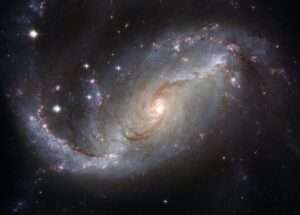Arab Contributions to Astronomy

Astronomy is the study of stars, planets, and other celestial objects. It’s been around for thousands of years, and it has fascinated humans for just as long. Did you know that Arab astronomers made significant contributions to the study of astronomy? As part of our Arab American Heritage Month series, we are sharing some fun facts about Arab contributions to astronomy. Plus, scroll to the end to see our recommendations for exploring the night sky.
Navigating the stars
One of the most important contributions Arab astronomers made to astronomy is the invention of the astrolabe. The astrolabe is a tool used to measure the height of stars and planets in the sky. One Arab scientist, Abd Al-Rahman Al-Sufi, wrote a book in the 10th Century, which described 1,000 uses for the astrolabe in astronomy and in daily life. In the 11th Century, another Arab astronomer, Al-Zarqali, perfected the universal astrolabe. Unlike earlier versions, which were based on a particular altitude, the new version could be used anywhere in the world. In the 12th Century, Arab women played a major role in the design and construction of astrological instruments. One such woman, Mariam Al-Ijliya, is credited with greatly improving the accuracy of astrolabes. The astrolabe was an important invention because it made it easier for astronomers to study the sky more accurately and laid the groundwork for future advancements, such as GPS and other navigation methods.
Charting the stars
Arab astronomers built on the work of Ptolemy to chart the positions and celestial paths of stars, planets, galaxies, and other celestial objects. They compiled star charts to record all of the information. The most comprehensive of these charts was the “De Magnis Coniunctionibus,” or “Great Conjunctions”, which included the positions of more than 1,000 stars. This chart served as a reference for astronomers for identifying specific stars in the night skies.
Galaxy Quests
Arab astronomers were the first to describe the Milky Way as a band-like feature in the sky. This was important because it helped astronomers understand more about our galaxy. Abd Al-Rahman Al-Sufi was also the first astronomer to recognize the Andromeda Galaxy, our closest neighbor galaxy.
Understanding How We See
While Ibn al-Haytham was one of the most famous Arab astronomers, his work had implications far beyond the study of the night sky. He was a pioneer of the scientific method, arguing that true scientific discovery could only be achieved through controlled experimentation. Alhazen also changed our understanding of sight. During the 10th Century, people believed that our eyes emitted light like a flashlight. In his book, The Book of Optics, Alhazen explained that light entered into our eyes, not the other way around. His book was later translated into Latin and influenced the development of optics in Europe.
From the invention of the astrolabe to the development of the star chart and observations of the Milky Way to demystifying human sight, Arab astronomers played a crucial role in our understanding of the universe. They were pioneers of scientific and mathematical thought, and their contributions paved the way for modern-day astronomy. Important Arab astronomers are honored with namesake craters on the moon and 165 stars in our skies that still bear their Arabic names. So, next time you look up at the night sky, think about the Arab astronomers who helped us better understand it!
What to learn more about astronomy and the night sky? Check out these resources:
Seattle Astronomical Society – Learn about stars, planets, moons, and other celestial objects through free public stargazing events (Star Parties). Bring your binoculars as you learn to navigate the night skies around Seattle. Star Parties are kid-friendly, and society members provide support and the opportunity to look through their telescopes.
Willard Smith Planetarium at Pacific Science Center – Explore the galaxy through fun and insightful shows at the planetarium attached to the Pacific Science Center. The planetarium even offers special shows for preschoolers as young as two. Planetarium shows are included with museum admission. If you can’t make it in person, check out the Pacific Science YouTube channel for some virtual planetarium shows.
UW Planetarium at the University of Washington – The UW Planetarium offers free public shows in the evenings on the first Friday of the month. There are four scheduled shows throughout the evening, and you must reserve in advance. The planetarium also offers shows for larger private groups on Friday afternoons.
